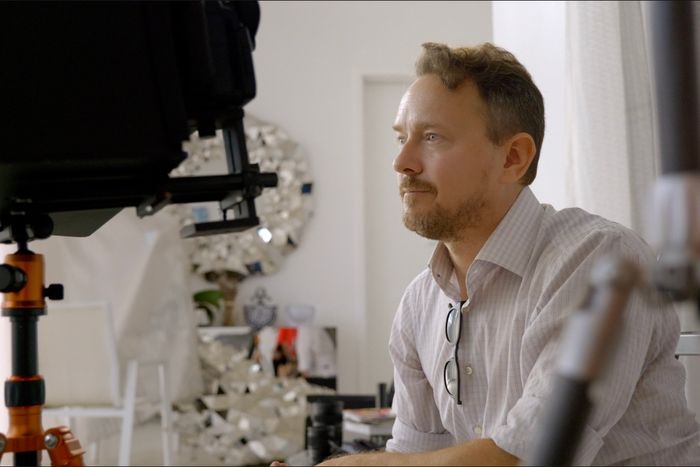

During the last 15 years, from the time Bitcoin has gone from a message-board curiosity to a fraud-adjacent currency a Wall Street goldmine, the name Peter Todd would be likely to draw blank looks from all but the most dedicated investors. Todd is a 39-year-old software developer known to have been involved with bitcoin since its early days, but he is not among the best-known names in the often weird, highly nerdy subculture of digital currencies. With the debut Tuesday of a new documentary on HBO making a circumstantial case that Todd is actually Satoshi Nakamoto, the mysterious and now mega-wealthy creator of bitcoin, that will change. Peter Todd is now, instantly, something of a household name.
Which is not to say he’s quite camera ready. To put it generously, Todd is terminally online. His internet persona tends to be caustic — quick with slurs and name-calling and a fondness for trolling (“I have one pet and it’s named your mom,” he wrote on X Tuesday). People who aren’t his biggest fans sometimes refer to him as “Toddler.” He has also been publicly accused of sexual abuse. (He denies it.) If the central theory Cullen Hoback’s latest film, Electric Money: The Bitcoin Mystery, is correct — to be fair, a big if — he is also probably one of the richest people on the planet, with a fortune of about $65 billion based on controlling a stash of 1.1 million bitcoins.
Let’s establish up front that Todd now strenuously denies being Nakamoto. “For the record, I’m not Satoshi,” he told me in an email. This is a more straightforward denial than any he gives in the documentary. Todd, an acknowledged and known developer on bitcoin’s core code, has at times answered this question in a way that left a bit more wiggle room. A typical example of his earlier denials looked like this: “I’m not Satoshi … which is a pretty suspicious really, given it’s exactly the kind of thing Satoshi would say. :)” That was an email he sent to a fact-checker for The New Yorker. (He forwarded the exchange to me.) Is it trolling, or is it deflection?
Photo: courtesy HBO
Hoback’s documentary follows the 2021 documentary miniseries QAnon: Into The Storm, which built a strong case that 8Chan proprietor Ron Watkins was the voice behind the Trump-era conspiracy theory that demonic liberals are trafficking children to drink their blood. In a somewhat similar vein, Electric Money seeks to discover the real identity of the person, or people, who created the world’s first real cryptocurrency, one of the truly world-changing ideas of the 21st century. Q and Nakamoto are both shadowy figures around whom wild stories and speculation have flourished. Hoback is a game documentarian, willing to travel the world to make his case, and both films climax in pivotal confrontations.
Where they differ is in how Cullen makes his case. Watkins slipped up during a video call and seemed to confirm — before correcting himself — that he was controlling the Q account. Todd offered no such bombshell. The reveal, instead, is Hoback’s own read on already-public and largely circumstantial information. It is a shift not in the facts but in the interpretation of them.
Hoback isn’t the first to speculate that Todd, who undeniably was early to get involved with bitcoin and has played a meaningful role in developing the software, is Nakamoto. Previous versions of the case have focused on his family history — his father is an economist — and an early interest in cryptography. But he has always a second- or third-tier suspect, never among the short list of leading candidates.
Electric Money is far from the first journalistic attempt to put an identity to the Nakamoto pseudonym. Previous efforts have not fared well. A widely derided Newsweek story in 2014 claimed a 64-year-old California man named Dorian Nakamoto was the inventor, only for the man to later threaten to sue for allegedly “reckless reporting.” (The magazine updated its stories with his denials.) A year later, both Wired and Gizmodo published stories that pointed to Australian businessman Criag Wright as the bitcoin’s creator, based on a trove of documents and emails that purported to reveal his intimate involvement. Since then, a court in the U.K. found that Wright lied “extensively and repeatedly” about his involvement, including forging documents “on a massive scale,” and he is now facing criminal perjury charges. The New Yorker also appears to have given the mystery a try but didn’t get very far.
Hoback’s theory involves another potential Nakamoto and known early bitcoin developer: Adam Back, a British-born technologist whose earlier inventions, like bitcoin precursor Hashcash, were crucial in the development of cryptocurrencies. Back was, in fact, one of the people Nakamoto first emailed in 2008, prior to the release of the bitcoin white paper, asking about citations for his earlier work. But after focusing on Back for a while, Hoback started to look elsewhere. “I had gone through this process of trying to disprove Adam for a long time,” Hoback told me over a Zoom call. “I just did the thought experiment where: What if everything Adam said, what if he’s not lying? What if Satoshi really had reached out asking for help with the white paper? What if his narrative was largely true? Then who would he be willing to lie to protect?”
Enter Todd, who, as a teenager, was emailing with cypherpunks like Back as early as 2001. Todd goes back and forth throughout the movie about how close he is to Back, but at one point concedes that the older developer was something like a father figure to him. Hoback establishes that Todd had a remarkable ability to code creatively — he studied art in college — and incorporated some of the same ideas about digital time-keeping that ended up in bitcoin into his artwork at the time.
This is where things get tricky. Hoback offers two main pieces of evidence that Todd actually created bitcoin, both of which are circumstantial. The first is a December 10, 2010 post on an early bitcoin forum by Todd, when he was about 25 years old. The post, about minute details in how bitcoin transaction fees worked, is written in response to a post by Nakamoto. It was among Todd’s earliest on the forum, and, in his telling, he is merely correcting a mathematical mistake by Nakamoto.
To Hoback, however, the post looks like Todd is continuing Nakamoto’s thoughts. In the movie, Hoback makes the case that Todd had, essentially, switched in and out of accounts, and forgot to log back in under the right alias. From there, Todd became the main focus of the filmmaker’s search. “I was like, ‘Okay, that’s enough to really start looking at him,’” Hoback said. “Then I spent just the next week trying to disprove that it could be him, and I was struggling to do that. The list of clues against him were very short. The ‘for’ list — everything seemed to kind of align.”
The other load-bearing piece of evidence relates to the large stash of bitcoins believed to be controlled by Nakamoto. These early bitcoins have never been moved from their digital wallets, according to researchers. That has led to speculation that Nakamoto has either died, destroyed his own access to the wallets, or is still just sitting on them. Near the end of the movie, Hoback brings up an undated chat transcript from Todd, where he appears to be talking about relinquishing his own access to a stash of bitcoin. “I’m probably the world’s leading expert in how to sacrifice your bitcoins (a rather dubious honor …) and I’ve done exactly one such sacrifice and I’ve done it by hand,” he said. The suggestion? That the “sacrifice” Todd is talking about is the abandonment or burning of Satoshi’s 1.1 million bitcoin.
Todd is adamant that is not what he was saying. “If Cullen put that in the movie, it’s a sign of him not doing his research,” Todd told me. “Notice the sarcasm in my statement — ‘a rather dubious honor’ — I’m making fun of the fact that at the time I was a world-leading expert in a relatively simple cryptographic technique that not that many people knew about, because bitcoin had (at the time) invented only a few years ago. It’s a dubious honor because, once bitcoin has been invented, the idea is so simple any decently competent cryptographer could have come up with it.” By his account, he was just talking about obscure wrinkle in how bitcoin worked — not bragging about burning a pile of money like the Joker.
Hoback does not definitively say that Todd is Nakamoto, though he comes close. “I obviously made the film. And, I mean, I’m very convinced,” he told me. There’s no question that the overall body of evidence — pored over many times — hardly gives a satisfying answer. Adam Back is adamant that it will remain a mystery. “My supposition for some years now is that, given that nobody found anything electronic, that we’re probably never going to know, and so what’s left is more circumstantial,” Back told me. “He clearly put planning and effort to stay anonymous, and based on the fact that nobody found anything for the last 15 years, it looks like he was completely successful and didn’t make any mistakes. So it doesn’t seem likely to me that he would get identified after that if he was intending to not be.”
Todd, who hadn’t seen the movie when I talked with him, criticized Hoback for not doing more research into him, including talking with his friends and family from 2008, the time when Nakomoto was known to be developing the bitcoin idea. (“There’s only so much sniffing around that you want to do around that,” Hoback told me.) Then again, he also didn’t respond to me when I asked him what he was doing at that time that would prove he wasn’t making bitcoin.
Todd argues that Hoback’s circumstantial case is not enough. “Accusing people of being Satoshi places big risks on them,” Todd said in an email. “Much the same way that QAnon got a lot of innocent people hurt because crazy conspiracy believers did things like break into pizza joints looking for kidnapped children, falsely accusing someone of having a fortune in bitcoin obviously invites all kinds of harms from people trying to steal that fortune. Given Cullen Hoback’s experience with QAnon, he should know better.”
Source link





